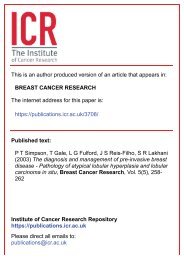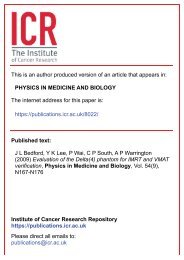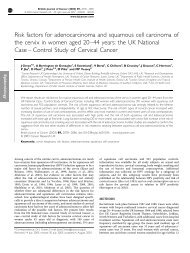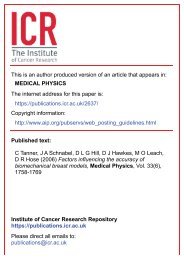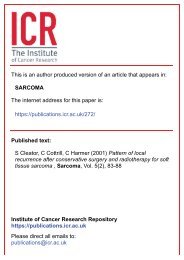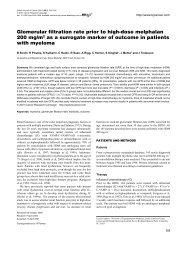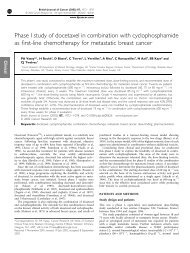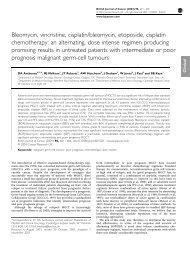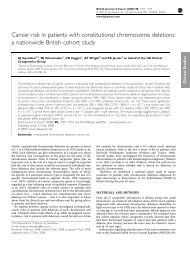Transcriptome analysis of mammary epithelial subpopulations ...
Transcriptome analysis of mammary epithelial subpopulations ...
Transcriptome analysis of mammary epithelial subpopulations ...
You also want an ePaper? Increase the reach of your titles
YUMPU automatically turns print PDFs into web optimized ePapers that Google loves.
BMC Genomics 2008, 9:591http://www.biomedcentral.com/1471-2164/9/591Additional file 2Relative expression levels <strong>of</strong> 2182 Affymetrix probes across three virginmouse <strong>mammary</strong> <strong>epithelial</strong> <strong>subpopulations</strong>. The spreadsheet gives therelative expression levels for all differentially expressed probes across allthree populations. Expression levels are indicated by a relative abundancescore for each populations. A high positive value indicates expression at ahigh level, a low negative score indicates very low expression levels. TheAffymetrix probe ID, Gene Symbol and q-value (indicating the % falsediscovery rate) are also indicated.Click here for file[http://www.biomedcentral.com/content/supplementary/1471-2164-9-591-S2.xls]Additional file 3Full heat map and hierarchical cluster <strong>analysis</strong> <strong>of</strong> differential geneexpression across virgin <strong>mammary</strong> <strong>epithelial</strong> populations. The imageshows heat map clustering <strong>of</strong> differentially expressed genes across the threecell populations. Red indicates high expression, green indicates low expression.Click here for file[http://www.biomedcentral.com/content/supplementary/1471-2164-9-591-S3.tiff]Additional file 4Genes characteristic <strong>of</strong> basal/myo<strong>epithelial</strong> cells. The table shows all861 genes in the basal/myo<strong>epithelial</strong> population with an abundance score<strong>of</strong> 2 or more when the 1427 differentially expressed gene set was sorted bydescending abundance scores in the basal/myo<strong>epithelial</strong> population. Suchgenes were considered characteristic <strong>of</strong> the population. Where differentialgene expression was indicated by more than one probe, an average valuefor each <strong>of</strong> the contrasts across the probes was calculated. The number <strong>of</strong>probes is indicated.Click here for file[http://www.biomedcentral.com/content/supplementary/1471-2164-9-591-S4.xls]Additional file 5Genes characteristic <strong>of</strong> luminal ER - cells. The table shows all 326 genesin the luminal ER - population with an abundance score <strong>of</strong> 2 or more whenthe 1427 differentially expressed gene set was sorted by descending abundancescores in the luminal ER - population. Such genes were consideredcharacteristic <strong>of</strong> the population. Where differential gene expression wasindicated by more than one probe, an average value for each <strong>of</strong> the contrastsacross the probes was calculated. The number <strong>of</strong> probes is indicated.Click here for file[http://www.biomedcentral.com/content/supplementary/1471-2164-9-591-S5.xls]Additional file 6Genes characteristic <strong>of</strong> luminal ER + cells. The table shows all 488 genesin the luminal ER + population with an abundance score <strong>of</strong> 2 or more whenthe 1427 differentially expressed gene set was sorted by descending abundancescores in the luminal ER + population. Such genes were consideredcharacteristic <strong>of</strong> the population. Where differential gene expression wasindicated by more than one probe, an average value for each <strong>of</strong> the contrastsacross the probes was calculated. The number <strong>of</strong> probes is indicated.Click here for file[http://www.biomedcentral.com/content/supplementary/1471-2164-9-591-S6.xls]Additional file 7Summarised gene expression microarray and qPCR gene expression<strong>analysis</strong> for 58 test genes. The table shows a comparison between thegene expression patterns determined by microarray <strong>analysis</strong> and thosedetermined by qPCR. The gene expression microarray relative abundancescores are summarised as follows: --- = -32 to -22, -- = -22 to -12, - = -12to -2, +/- = -2 to +2, + = 2 to 12, ++ = 12 to 22, +++ = 22 to 32, ++++= 32 to 42. Where more than one identifier for a gene scored as differentiallyexpressed, the mean score across all the identifiers was used to determinethe summarised microarray score. The summarised score was in turnused to define the array-based expression pattern, with a score <strong>of</strong> +, ++,+++ or ++++ indicating that a gene was expressed in a particular population.In some cases, the genes were expressed in more than one population.The summarised qPCR expression pattern is based upon the patterns <strong>of</strong>gene expression determined from Figure 3. Whether or not the array andqPCR based analyses show concordance in their assignment <strong>of</strong> expressionpatterns is indicated. NDE = no differential expression in microarray. N/A = comparison cannot be made as qPCR probe failed. *In these comparisons,technical failure <strong>of</strong> the Affymetrix probe cannot ruled out.Click here for file[http://www.biomedcentral.com/content/supplementary/1471-2164-9-591-S7.xls]Additional file 8Comparison <strong>of</strong> numbers <strong>of</strong> genes identified in common between basal/myo<strong>epithelial</strong>, luminal ER - and luminal ER + cells and previously publisheddatasets. The table compares previously published datasets with thesubpopulation specific genes identified in the current <strong>analysis</strong>. Publishedlists <strong>of</strong> genes [27,28], probes [6] or SAGE tags [29] significantly differentiallyexpressed between mouse basal <strong>mammary</strong> stem cell enriched/myo<strong>epithelial</strong> cells compared to in vitro colony forming cells (luminalcells) [6], human CD10 - CD44 + basal cells compared to CD24 + luminalcells [29] or human CD10 + myo<strong>epithelial</strong> cells compared to EMA + luminalcells [27,28] were condensed to remove multiple probes or tags againstthe same gene and to identify only well-annotated genes. The distribution<strong>of</strong> the differentially expressed genes in the basal/myo<strong>epithelial</strong>, luminalER - and luminal ER + gene lists from the current study was then determined.Click here for file[http://www.biomedcentral.com/content/supplementary/1471-2164-9-591-S8.xls]Additional file 9List <strong>of</strong> genes common to basal/myo<strong>epithelial</strong> cells and previously publishedbasal or myo<strong>epithelial</strong> datasets. The table lists those basal/myo<strong>epithelial</strong>genes found in previously published datasets which were also foundthe basal/myo<strong>epithelial</strong> population in the current study.Click here for file[http://www.biomedcentral.com/content/supplementary/1471-2164-9-591-S9.xls]Additional file 10List <strong>of</strong> genes common to luminal cell <strong>subpopulations</strong> and previouslypublished luminal datasets. The table lists those luminal genes found inpreviously published datasets which were also found the luminal populationsin the current study.Click here for file[http://www.biomedcentral.com/content/supplementary/1471-2164-9-591-S10.xls]Page 24 <strong>of</strong> 28(page number not for citation purposes)



